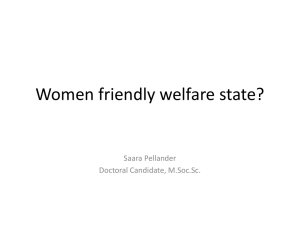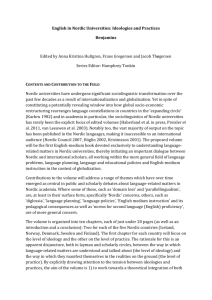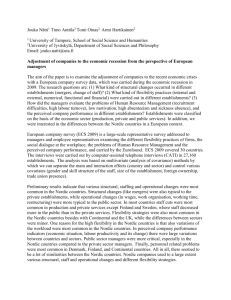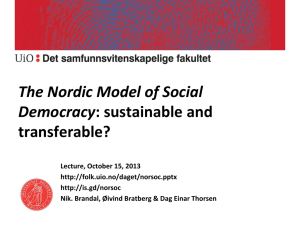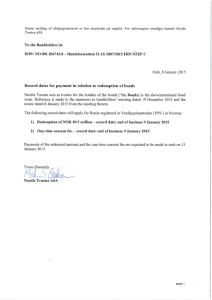Courseolan_Nordic_2008
advertisement
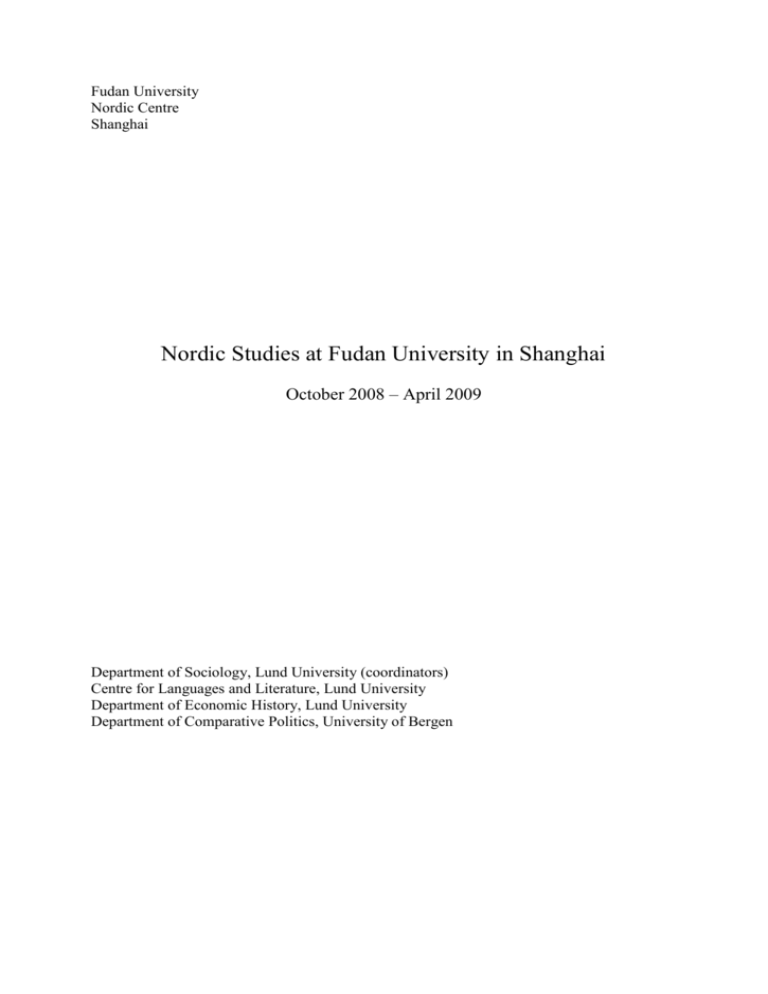
Fudan University Nordic Centre Shanghai Nordic Studies at Fudan University in Shanghai October 2008 – April 2009 Department of Sociology, Lund University (coordinators) Centre for Languages and Literature, Lund University Department of Economic History, Lund University Department of Comparative Politics, University of Bergen Course in Nordic Studies at Fudan University in Shanghai The course corresponds to 12,5 credits in the European Union credit transfer system (ECTS), corresponding to 8 weeks of full-time study. Participating departments: Centre for Languages and Literature, Departments of Economic History and Sociology at Lund University, Sweden, and Department of Comparative Politics at University of Bergen, Norway. This course is designed for non-Nordic students without previous knowledge of the Nordic countries. Familiarity with basic concepts and perspectives from cultural and social sciences is an advantage. However, it is not a precondition for participating in the course. The students are supposed to have English language proficiency to a level that enables them to take active part in the seminar discussions and to prepare the papers associated with the course. Scholarships for studies in the Nordic countries are available for students participating in the course. Course structure The course consists of two sub-courses: 1. Modernity and The Making of Modern Nordic Societies from Economic, Political, Sociological, Cultural Perspectives (7,5 ECTS) 2. Essay (5 ECTS) INTRODUCTORY COURSE IN NORDIC STUDIES (12,5 ECTS) Sub-course 1. Modernity and The Making of Modern Nordic Societies from Economic, Political, Sociological and Cultural Perspectives (7,5 ECTS) Part 1a. Aspects of Modernity - An Introduction (1,5 ECTS) The formation of modernity in Nordic societies is the focus for the whole course. We will first provide an introduction to the course. In this introduction, the processes, which led to the formation of modern societies in Europe, are discussed more generally. Questions like when, how, and why modern societies in Europe first emerged will be discussed. How did they assume the forms and structure they did? The introduction will give a short overview of sources for the rapid and extensive social, cultural, and economic development, which followed the decline of feudalism in Western Europe. This part is common for students from all disciplines. Compulsory readings Hall, Stuart & Bram Gieben. 1993. Formations of Modernity. Cambridge: Polity Press and The Open University (read chapters 2, 3 and 4). Berman, Marshall. 1988. All That is Solid Melts into Air: The Experience of Modernity. Penguin. 15-36. Part 1b. The Making of Modern Nordic Societies - general part (3,5 ECTS) This section of the course will provide an introduction to the formation of the modern Nordic societies, from four different perspectives: economic historical, political, sociological, cultural, and human rights. Compulsory readings for these four perspectives are presented below. This part is common for students from all disciplines. Sociological Perspective Esping-Andersen, Gösta. 1990. The Three Worlds of Welfare Capitalism, 9-34. Cambridge: Polity Press. Frykman, Jonas. 1992. “In Motion. Body and Modernity in Sweden between the World Wars”. Ethnologia Scandinavica, Vol. 22, 36-51. Pred, Allan. 1995. Recognizing European modernities. Routledge: London. 97-175. Rauch, Dietmar. 2007. “Is There Really a Scandinavian Social Service Model? A Comparison of Childcare and Elderlycare in Six European Countries”. Acta Sociologica, 50(3): 249-269. Cultural Perspective Algulin, Ingemar. 1989. A History of Swedish Literature, 108-132, 157-171, 215-219, 229245, 259-265. Stockholm: The Swedish Institute. Strindberg, August. 1879. The Red Room (first chapter in Chinese translation). Economic Historical Perspective Bruland, Kristine & Wicken, Olav, 2003, "Modern Norway", in J. Mokyr (ed.), The Oxford Encyclopedia of Economic History, vol. 4, Oxford University Press. Hjerppe, Riitta 2003, "Modern Finland" in J. Mokyr (ed.), The Oxford Encyclopedia of Economic History, vol. 4, Oxford University Press. Johansen, Hans Christian 2003, "Modern Denmark", in J. Mokyr (ed.), The Oxford Encyclopedia of Economic History, vol. 4, Oxford University Press. Krantz, Olle, 2003, "Modern Sweden", in J. Mokyr (ed.), The Oxford Encyclopedia of Economic History, vol. 4, Oxford University Press. Ljungberg, Jonas 2003, "Nordic Countries: General Overview", in J. Mokyr (ed.), The Oxford Encyclopedia of Economic History, vol. 4, Oxford University Press. Ljungberg, J. 2006, "Economic Growth and Change in EU15 As Seen in a Swedish Mirror", Working paper. Ljungberg, Jonas & Schön, Lennart, 2001, "Domestic Markets and International Integration. Paths to Industrialization in the Nordic Countries", Mimeo. World Economic Forum publishes annually a "Global Competitiveness Index" (GCI); this year it will appear on 31 October but last year's edition can be found at http://www.weforum.org/pdf/Global_Competitiveness_Reports/Reports/gcr_2006/gcr2006_su mmary.pdf The literature will be completed with handouts by the teacher. Political Science Perspectives Knut Heidar (2004) (ed.): Nordic Politics. Comparative Persepctives. Universitetsforlaget (around 100 pages) Part 1c. The Making of Modern Nordic Societies – subject specific part (2,5 ECTS) The final part of sub-course 1 is subject-specific. Each student must choose and pursue one of the presented perspectives below. It is assumed, that most students will choose perspectives corresponding with the department with which they are affiliated at Fudan University; however, students are allowed to choose freely any perspective they prefer. Sociological Perspective The purpose of the sociological part of the course is to give the students a general introduction to social and cultural processes associated with the development of the modern Nordic welfare state. The course will present some key social institutions that together have come to be called the "Nordic model". The course presents the historical development of the welfare state, both in relation to institutional changes and to the political project of the welfare state, and discusses current challenges to this model. The course starts with an introduction that will present the historical development of the Nordic model. In doing so, it discusses the political terrain of the welfare state as well as present important elements of the structure that taken together have been termed "the Nordic model". Thereafter follows a section discussing the relation between economic development, political forces, and the welfare state. An essential question that will be examined in this section is to what extent the development of the welfare state is related to a certain class constellation and economic phase. The labour market has been the essential institution through which the welfare state has met and intervened on the market. We will discuss the particularities and the formation of the Nordic model of labour market regulation and industrial relations. Divisions and structures in the labour market will be approached with an emphasis on aspects of class and gender. The family, gender, and children have been seen as legitimate spheres of state intervention in the Nordic model. From the historic writings of among others Social Democratic intellectuals the course will discuss the welfare state policies directed towards the social sphere of the family and everyday life. Selected readings (250-300 pages) Benner, Mats. 2003. “The Scandinavian Challenge: The Future of Advanced Welfare States in the Knowledge Economy”. Acta Sociologica 2003 46: 132-149. Blackman, Tim. 2000. Defining responsibility for care: approaches to the care of older people in six European countries. International Journal of Social Welfare, 9: 181-190. Guo, Jing & Neil Gilberg. 2007. Welfare state regimes and family policy: a longitudinal analysis. International Journal of Social Welfare, 16: 307-313. Huber, Evelyne & John D. Stephens. 2002. Globalisation, Competitiveness, and the Social Democratic Model. Social Policy & Society, 1:1, 47-57. Jewell, Christopher J. 2007. Assessing Need in the United States, Germany, and Sweden: The Organization of Welfare Casework and the Potential for Responsiveness in the “Three Worlds”. Law & Policy, Vol. 29, No. 3, 381-406. Korpi, Walter. 2000. Faces of Inequality. Gender, Class and Patterns of Inequalities in Different Types of Welfare States. Luxemburg Income Study Working Paper No. 224(February): Available online: http://www.lis.ceps.lu/wps/224.pdf Korpi, Walter & Joakim Palme. 1998. The Paradox of Redistribution and Strategies of Equality. Welfare State Institutions, Inequality, and Poverty in Western Countries. Luxemburg Income Study Working Paper No. 174: Available online: http://www.lis.ceps.lu/wps/174.pdf Mishra, Ramesh. 1999. Globalization and the Welfare State, 1-17, 74-80, 90-92, 95-109. Cheltenham: Edward Elgar. Nordheim-Nielsen, Fritz. 1988. The Scandinavian Model – Reformist Road to Socialism or Dead End Streets?, 1-37. Nordlund, Anders. 2000. Social policy in harsh times. Social security development in Denmark, Finland, Norway and Sweden during the 1980s and 1990s. International Journal of Social Welfare 2000: 9:31-42. Sandqvist, Gertrud. “Art and Social Democracy”. http://www.rollon.net/artiklar/gertrud/indexe.html Cultural Perspectives The aim of part 1 B of the study is to give the students a general introduction to the history of modern Swedish literature. The course starts with a survey of Swedish literature from August Strindberg to Lars Norén and continues with an analysis of Strindberg’s novel The Red Room (Röda rummet) from 1879. Special emphasis will be given to the so called ”Modern Breakthrough” in Scandinavian literature and to the conflict between nature and modernity as one of the most important themes in the literary works from this period. By reading Strindberg’s novel more closely (1 C) we will be able to discuss the impact and sometimes tragic consequences of the industrialization and urbanization of the Swedish society and at the same time reflect upon the literary techniques used to depict the breakthrough of modernity. Special attention will be paid to Strindberg’s vision of the relationship between nature and society, but we will also investigate the satirical force of his novel and reflect upon the hero’s development from a bohemian and idealistic outsider to a rather well integrated citizen in bourgeois society. During the course the students will also be given the opportunity to watch a film of more recent date concerning problems that are related to the development of modernity in Scandinavia. Selected readings (250-300 pages): Strindberg, August. 1879. The Red Room (in Chinese translation). Economic Historical Perspective The aim is to study the growth and transformation of the Nordic economies in a long term perspective, from the early 19th century up to the present. An overview is given of four great economic and social transformations. The first was commercialization and enclosure movement within the agricultural society. The second was the early industrialization that could be seen both as a continuation of the previous transformation, and as a response to changes in the international economy. The third transformation, around the turn of the century 1900 and often denominated as the Second Industrial Revolution, paved the way for the modern industrial societies. During the last quarter of the 20th century the Nordic countries experienced a fourth transformation, alternatively denominated as the Third Industrial Revolution or as the Post-Industrial Transformation resulting in the service society. As a characteristic of this transformation, industrial production has continued to grow, however, the share of industry in employment and total production has diminished. Different aspects of these four transformations are discussed. A first aspect is about structural change, that is, the changing importance of agriculture, industry, and services respectively. Natural resources and the structure of industry in each country are also outlined. The crises of the 1930s and the late 1970s are notified. A second aspect is about the demographic changes that have been as profound as the structural changes, yet the causal relationships are not easy to pinpoint. A third aspect is about institutional change, including economic policy. A particular interest is devoted to the development of the welfare state and the regulation, as well as the recent deregulation, of capital markets. A fourth aspect is about the long-term economic growth in the Nordic countries. What were their income levels, and growth performance, in an international comparison during the 19th and 20th centuries? The economic growth of the Nordic countries is seen in relation to the international economy which has gone through periods of globalization as well as de-globalization. Selected readings (250-300 pages) Bengtsson, Tommy & Ohlsson, Rolf, 1994, "The Demographic Transition Revised", in T. Bengtsson (ed.), Population, Economy and Welfare in Sweden, pp. 13-30, Berlin: Springer Verlag. Björklund, Anders, 1999, "Going Different Ways: Labour Market Policy in Denmark and Sweden" (in Esping-Andersen and Regini (eds) Why Deregulate Labour Markets?, Oxford: Oxford University Press, pp. 148-180. Jaumotte, Florence, 2003, "Female Labour Force Participation: past Trends and Main Determinants in OECD Countries", OECD Economics Department Wprking Paper No. 376 Ljungberg, J. 2006, "Economic Growth and Change in EU15 As Seen in a Swedish Mirror", Working paper. Ljungberg, Jonas, 2006, "Structural Cycles in the Swedish Economy", Mimeo. Kautto, Mikko & Kvist, Jon, 2002, "Distinct or Extinct? Nordic Welfare States in the European Context", The Danish National Institute of Social Research Working Paper Series 07:2002. Maskell, Peter, 1996, "Learning in the village economy of Denmark. The role of institutions and policy in sustaining competitiveness", DRUID Working Paper No. 96-6. Sandal, Knut, 2004, "The Nordic banking crises in the early 1990s - resolution methods and fiscal costs", ch. 3 in T.G. Moe, J.A. Solheim and B. Vale (eds.), The Norwegian Banking Crisis, Norges Bank: Occasional Paper 33 (www.norges-bank.no). Virén, Matti and Malkamäki, Markku, 2002, "The Nordic Countries", in B. Steil, D.G. Victor and R.R. Nelson (eds), Technological Innovation and Economic Performance, Princeton: Princeton University Press, pp 200-26. Political Science Perspective The purpose of the course in Nordic Politics is to provide the student with knowledge about the basic political structures and modernisation processes in the Nordic countries, and to familiarise the student with central theories explaining Nordic society. The course will focus on the processes of state and nation building, democratisation, and mass mobilisation in the Nordic countries. Further, the course will present the characteristics of the Nordic type of welfare states, offers explanations to why the Nordic countries have developed a distinct type of welfare state, and discusses the social and political consequences of various types of institutional welfare provision. Finally, the course will discuss present and future challenges to the Nordic and European welfare states. In their work with essays, students are encouraged to write their papers on topics like: The Nordic Welfare States, Women in Nordic politics, Ethnic minorities in the Nordic countries, Voluntary organizations in the Nordic countries, Political parties and elections in the Nordic countries, Parliaments and executives in the Nordic countries, The Nordic Countries, and the European Union. Selected readings 250-300 pages of selected readings, in consultation with the supervisor. Assignments for sub-course 1 As examination the students must write two papers: 1) one group paper related to Aspects of Modernity/The Making of Modern Nordic Societies (parts 1a and 1b above), and 2) one individual paper related to the subject specific part (part 1c above). Sub-course 2. Essay (5 ECTS) As examination the students will write a discipline specific essay (6-8 pages), with both virtual supervision during the whole sub-course. The essay is presented in a final seminar in April 2009.
